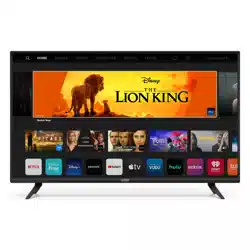Documents: Go to download!
User Manual
- Owner's manual - (English)
- Quickstart Guide - (English)
- Getting to Know Your TV
- Completing The First-Time Setup
- Using the On-Screen Menu
- SETTING UP CLOSED CAPTIONING
- SmartCast TV
- Playing USB Media
- HELP TOPICS
Table of contents
User manual Television
Getting to Know Your TV

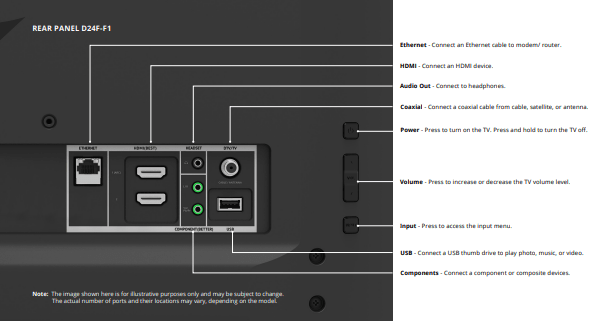
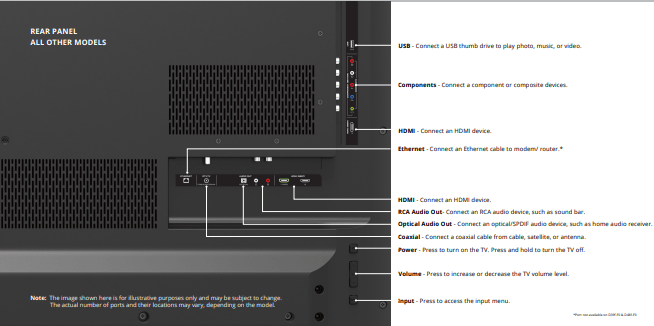
WALL-MOUNTING THE TV
To mount your TV on a wall, you will need a wall mount. Consult the information on this page to find the appropriate mount for your TV. Be sure the mount you choose is capable of supporting the weight of the TV. After you have determined that you have the correct mount for your TV, you can begin the installation.
To install your TV on a wall:
- Disconnect any cables connected to your TV.
- Place the TV face-down on a clean, flat, stable surface. Be sure the surface is clear of debris that can scratch or damage the TV.
- Remove the stands by loosening and removing the screws.
- Attach your TV and wall mount to the wall, carefully following the instructions that came with your mount. Use only with a UL-listed wall mount bracket rated for the weight/load of this TV.
Installing a TV on a wall requires lifting. To prevent injury or damage to the TV, ask someone to help you.
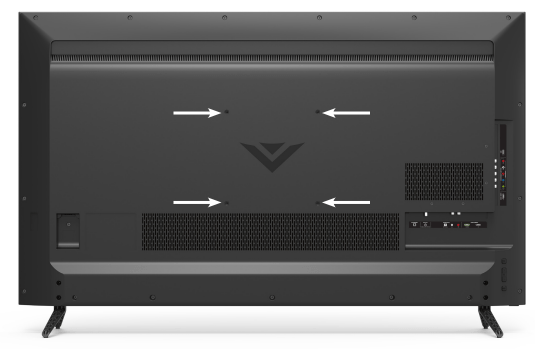

USING THE REMOTE

1. Input - Change the currently displayed input
2. Power - Turn Television on or off
3. App Launcher - Quickly launch the pictured app
4. Exit - Close the on-screen menu
5. Menu - Display the settings menu
6. Arrow - Navigate the on-screen menus
7. OK/Play/Pause - Select the highlighted menu option and play or pause content
8. Back - Go to the previous on-screen menu
9. Info - Display the info window
10. Volume Up/Down - Increase or decrease the loudness of the audio
11. Closed Caption - Open the closed caption menu.
12. V Button - Launch SmartCast TV/Return to SmartCast TV Home Screen
13. Pic - Cycle through the different picture setting modes
14. Channel Up/Down- Change the channel.
15. Mute - Turn the audio on or off
16. Last - Return to the last viewed channel..
17. Number Pad - Manually enter a channel
18. Wide - Change the Television mode.
19. Dash - Use with number pad to manually enter a digital sub-channel. (e.g. 18-4 or 18-5)
Replacing the Batteries
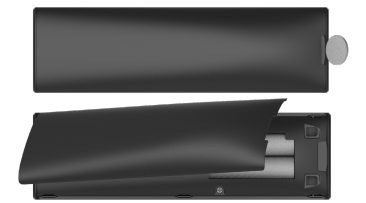
- Find the notch on the back of the remote. Insert a coin and pry open the back cover.
- Insert two batteries into the remote control. Make sure that the (+) and (-) symbols on the batteries match the (+) and (-) symbols inside the battery compartment.
- Replace the battery cover.
WARNING: Keep the remote control batteries away from children. It may cause choking and/or lead to a fire or chemical burn if mishandled. Do not dispose of batteries in fire. Replace only with batteries of the correct type.
When needed, VIZIO recommends replacing the batteries that came with this remote with two, new Duracell ‘AAA’ alkaline batteries.

Completing The First-Time Setup
The first time you turn on the TV, the on-screen instructions will guide you through each of the steps necessary to get your TV ready for use:
Before you begin the first-time setup:
- Your Television should be installed and the power cord should be connected to an electrical outlet.
- If you have a wireless network, have the network password ready.
- If you are connecting to your network with an Ethernet cable, connect it to the Ethernet port* on the Television.
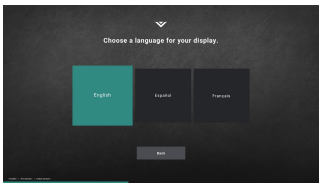
1. Choose your language.
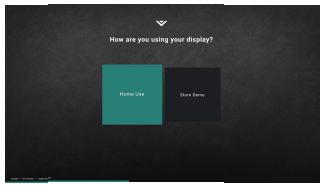
2. Choose home use.
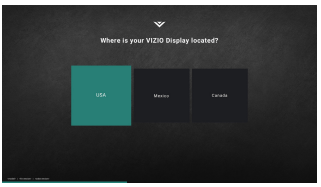
3. Choose your country.
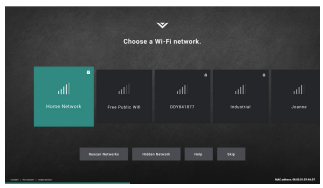
4. Choose your Wi-Fi and enter the password.
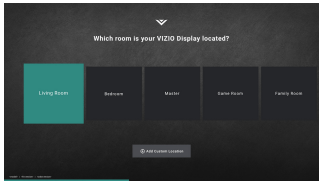
5. Name your TV.
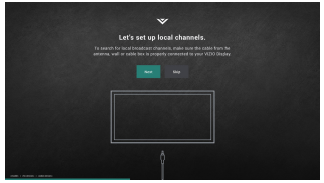
6. Scan for channels
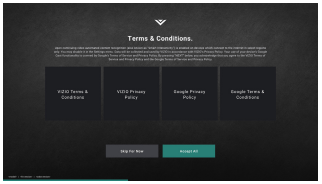
7. Accept the T&Cs and register your device.
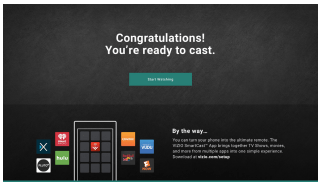
All set!
Using the On-Screen Menu
Your TV features an easy-to-use on-screen menu.
To open the on-screen menu, press the Menu button on the remote.
From this menu, you can:
• Adjust the Picture settings
• Adjust the Audio settings
• Adjust the Network settings
• Set up the Timers
• Adjust the Channel settings
• Set up Closed Captioning
• Name and adjust Inputs
• Adjust TV settings
• View user manual
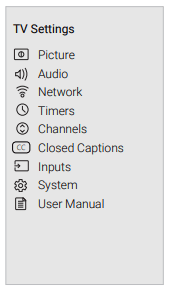
NAVIGATING THE ON-SCREEN MENU
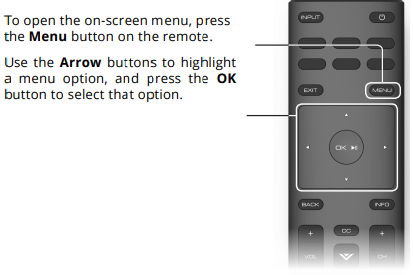
While navigating the on-screen menu, you can press the Back button at any time to return to the previous menu screen. The Exit button will close the onscreen menu.
CHANGING THE INPUT SOURCE
External devices such as DVD players, Blu-ray Players, and video game consoles can be connected to your TV. To use one of these devices with your TV, you must first change the input source using the INPUT menu.
To change the input sources:
- Press the Input button on the remote. The INPUT menu is displayed.
- Use the Right/Left Arrow buttons or the Input button on the remote to highlight the input you wish to view and press OK. The selected input is displayed.
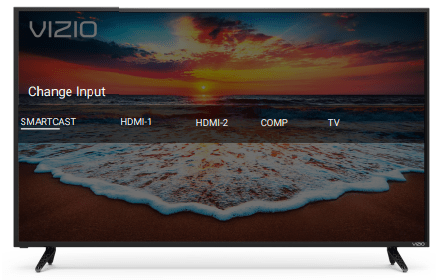
You can change the input names that appear on the INPUT menu to make your devices easy to recognize. See Renaming Devices on the Input Menu for more information.
CHANGING THE SCREEN ASPECT RATIO
The TV can display images in four different modes: Normal, Panoramic, Wide, and Zoom. Each mode displays the picture differently.
Some programs have black bars on the top or sides of the picture so that the picture keeps its original shape. Examples include wide-screen movies and older television programs.
To change the screen aspect ratio:
1. Press the Wide button on the remote.
2. Use the Arrow buttons to highlight the aspect ratio you wish to view and press OK .
- Normal preserves the content’s original aspect ratio and size.
- Panoramic stretches a 4:3 aspect ratio picture to the left and right edges of the screen. The center of the image is not stretched, but the sides of the image are extremely stretched. If you are watching widescreen (1.85:1 or 2.35:1) content with black bars on the top and bottom, the black bars will still appear on the top and bottom of the display image.
- Wide stretches a 4:3 aspect ratio picture to the edges of the screen. Since the picture is being stretched, the display image may appear distorted—figures appear short and fat. If the program is already formatted for widescreen viewing (1.85:1 or 2.35:1), then black bars will appear on the top and bottom of the display image.
- Zoom expands images evenly in all directions (33% taller and 33% wider) with black bars to fit the screen. A 720p image will fill a 1080p screen.
Tip: The aspect ratio cannot be changed for Ultra HD content or HDR content.

ADJUSTING THE PICTURE SETTINGS
Your TV display can be adjusted to suit your preferences and viewing conditions.
If you’ve made changes to the Settings for a picture mode, an asterisk appears after its name (see Saving a Custom Picture Mode).
To adjust the picture settings:
1. Press the Menu button on the remote. The on-screen menu is displayed.
2. Use the Arrow buttons on the remote to highlight Picture and press OK. The PICTURE menu is displayed.
Standard picture mode meets Energy Star® requirements. For the best picture, switch to Calibrated mode. Note that Calibrated mode does not meet Energy Star® requirements. Customizing picture settings will change the energy consumption required to operate the TV.
3. Use the Arrow buttons on the remote to highlight Picture Mode, then use the Left/Right Arrow buttons to change the picture mode:
- Standard mode sets the picture settings to the default settings.
- Calibrated mode sets the picture settings to values ideal for watching TV in a brightly-lit room.
- Calibrated Dark mode sets the picture settings to values ideal for watching TV in a dark room.
- Vivid mode sets the picture settings to values that produce a brighter, more vivid picture.
- Game mode reduces throughput delays and optimizes the picture settings for displaying game console output.
- Computer mode optimizes the picture settings for displaying computer output.
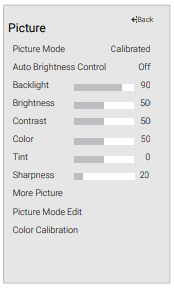
4. To manually change each of the picture settings, use the Up/ Down Arrow buttons on the remote to highlight that picture setting, then use the Left/Right Arrow buttons to adjust the setting:
- Auto Brightness Control - The auto brightness control detects the light levels in the room and automatically adjusts the backlight for the best picture. Select Off, Low, Medium, or High.
- Backlight - Adjusts the LED brightness to affect the overall brilliance of the picture. Backlight cannot be adjusted when starting from some picture modes.
- Brightness - Adjusts the black level of the picture. When this setting is too low, the picture may be too dark to distinguish details. When this setting is too high, the picture may appear faded or washed out.
- Contrast - Adjusts the white level of the picture. When this setting is too low, the picture may appear dark. When this setting is too high, the picture may appear faded or washed out. If the setting is too high or too low, detail may be difficult to distinguish in dark or bright areas of the picture.
- Color - Adjusts the intensity of the picture colors.
- Tint - Adjusts the hue of the picture. This setting is useful in adjusting the flesh tones in the picture. If flesh appears too orange, reduce the level of color before adjusting tint.
- Sharpness - Adjusts the edge sharpness of picture elements. It can be used to sharpen non-HD (high definition) content; however, it will not produce detail that does not otherwise exist.
5. When you have finished adjusting the picture settings, press the Exit button on the remote.
Adjusting More Picture Settings
To adjust MORE PICTURE settings:
1. From the PICTURE menu, use the Arrow buttons to highlight More Picture, and then press OK.
2. Use the Arrow buttons to highlight the setting you wish to adjust, then press the Left/ Right Arrow buttons to change the setting:
- Color Temperature - See Adjusting the Color Temperature.
- Black Detail - Adjusts the average brightness of the picture to compensate for large areas of brightness. Select Off, Low, Medium, or High.
- Backlight Control - Reduces blue in scenes with fast action. Some sensitive viewers
- Reduce Noise - Opens a sub-menu with two settings.:
- Reduce Signal Noise - Diminishes artifacts in the image caused by the digitizing of image motion content. Select Off, Low, Medium, or High.
- Reduce Block Noise - Reduces pixelation and distortion for .MPEG files. Select Off, Low, Medium, or High.
- Game Low Latency - Select On to reduce video delay (lag) when gaming.
- Pure Cinema Mode - Optimizes the picture for watching film. Select Auto or Off.
- Gamma - Set the shape of the Gamma curve. Use lower Gamma values for bright room conditions, and higher values when it’s dark.
3. When you have finished adjusting MORE PICTURE Settings, press the Exit button on the remote.
Locking/Unlocking a Custom Picture Mode
Custom picture modes can be locked/unlocked with a unique PIN to prevent accidental changes to their settings.
To lock all custom picture modes:
1. From the PICTURE MODE EDIT menu, use the Arrow buttons to highlight Lock Picture Mode, and then press OK. The LOCK PICTURE MODE menu is displayed.
2. Use the Number Pad on your remote to enter a unique 4-digit PIN. If a system PIN is set, then lock/unlock. If no system PIN is set, then you will be prompted to set a PIN.
3. Highlight Save and press OK.
4. Press the Exit button to exit the menu screens.

To unlock all custom picture modes:
- From the PICTURE MODE EDIT menu, use the Arrow buttons to highlight Unlock Picture Mode, and then press OK. The UNLOCK PICTURE MODE menu is displayed.
- Use the Arrow buttons to select Off.
- Use the Number Pad on your remote to enter your 4-digit PIN.
- Make any desired changes to the picture modes.
- Then turn on Lock Picture Mode.
- Press the Exit button to exit the menu screens.
Deleting a Custom Picture Mode
Custom picture modes that are no longer needed can be deleted.
To delete a custom picture mode:
- From the PICTURE MODE EDIT menu, use the Arrow buttons to highlight Delete Picture Mode, and then press OK. The DELETE PICTURE MODE window is displayed.
- Use the Left/Right Arrow buttons to highlight Delete and press OK.
- Press the Exit button to exit the menu screens.
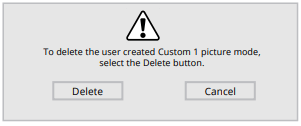
Resetting a Picture Mode
A preset picture mode that has been edited can be restored to the factory default settings.
To reset a customized preset picture mode:
- From the PICTURE MODE EDIT menu, use the Arrow buttons to highlight Reset Picture Mode, and then press OK. The RESET PICTURE MODE window is displayed.
- Use the Left/Right Arrow buttons to highlight Reset and press OK.
- Press the Exit button to exit the menu screens.
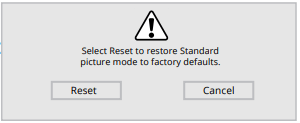
ADJUSTING THE AUDIO SETTINGS
To adjust the audio settings:
1. Press the Menu button on the remote. The on-screen menu is displayed.
2. Use the Arrow buttons on the remote to highlight Audio and press OK. The AUDIO menu is displayed.
3. Use the Arrow buttons to highlight the setting you wish to adjust, then press Left/ Right Arrow buttons to change the setting:
• Speakers - Turns the built-in speakers On or Off.
• Volume Control Display - Toggle between On or Off to hide or display the on-screen volume slider that appears when volume is adjusted.
• Surround Sound - Surround sound uses DTS TruSurround ™ to deliver an immersive surround sound experience from the TV’s internal speakers. TruSurround completes the entertainment experience by providing deep, rich bass and by delivering crisp details and clear, intelligible dialog. Select On or Off.
• Volume Leveling - Volume leveling uses DTS TruVolume ™ to maintain consistent volume levels during transitions between program content, AV formats, and input sources. Select On or Off. In a few cases, volume leveling may artificially suppress volume increases, making it difficult to hear dialog or flattening sudden noises. If this occurs, turn volume leveling off.
• Balance - Adjusts the loudness of the audio output from the left and right speakers.
• Lip Sync - Adjusts the synchronization between the display image and the accompanying audio track.
• Digital Audio Out - Changes the type of processing for digital audio out and HDMI ARC output when connected to a home theater audio system. Select Auto, PCM, Dolby D, or Bitstream .
• Analog Audio Out - Sets the volume control properties for the RCA connector when connected to a home theater audio system. Select Variable if you are controlling the volume with the TV’s volume controls, or select Fixed if an external audio device (sound bar or AV receiver) will control the volume.
4. When you have finished adjusting the audio settings, press the Exit button on the remote.
SETTING TIMERS
Setting the Timer
When activated, the TV’s timer will turn the TV off after a set period of time.
- Press the Menu button on the remote. The on-screen menu is displayed.
- Use the Arrow buttons on the remote to highlight Timers and press OK. The TIMERS menu is displayed.
- Use the Left/Right Arrow buttons on the remote to highlight the period of time after which you want the TV to go to sleep: 30, 60, 90, 120, or 180 minutes. If you don’t want the sleep timer to activate, change the setting to Off.
- When you have finished setting the sleep timer, press the Exit button on the remote.
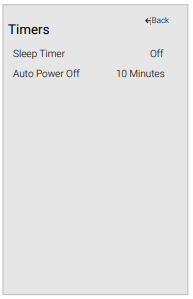
Setting the Auto Power Off Feature
To help save energy, your TV is set by default to turn off after 10 minutes without a video or audio signal. This feature can be deactivated.
To set the Auto Power Off feature:
- From the TIMERS menu, use the Up/Down Arrow buttons on the remote to highlight Auto Power Off.
- Use the Left/Right Arrow buttons on the remote to change whether the TV will turn off. If you don’t want the TV to turn off when there is no signal, change the setting to Off. Otherwise, select 10 minutes.
- When you have finished setting the auto power off time, press the Exit button on the remote.
LISTENING TO ALTERNATE AUDIO
Changing the Analog Audio Language
Some analog over-the-air (free) and cable channels broadcast programs in more than one language. The TV’s Analog Audio feature allows you to listen to audio in an alternate language using Secondary Audio Programming (SAP).
To use the Analog Audio feature:
1. From the CHANNELS menu, highlight Analog Audio and press OK. The ANALOG AUDIO menu is displayed.
2. Select Stereo, SAP (secondary audio programming), or Mono. Press OK.
3. Press the Exit button on the remote.
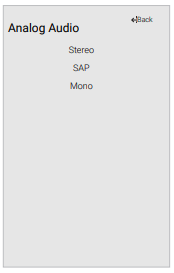
To use the Digital Language feature:
1. From the CHANNELS menu, highlight Digital Audio and press OK. The DIGITAL LANGUAGE menu is displayed.
2. Select your preferred language: English, Spanish/Video Description, French. Press OK.
3. Press the Exit button on the remote.

SETTING UP CLOSED CAPTIONING
Your TV can display closed captions for programs that include them. Closed captions display a transcription of a program’s dialogue.
To activate or deactivate closed captions:
1. Press the Menu button on the remote. The on-screen menu is displayed.
2. Use the Arrow buttons on the remote to highlight Closed Captions and press OK. The CLOSED CAPTIONS menu is displayed.
3. Use the Arrow buttons on the remote to highlight Closed Captions and then use the Left/ Right Arrow buttons to select On or Off.
4. Use the Arrow buttons on the remote to highlight either Analog or Digital Closed Captions.
5. Use the Left/Right Arrow buttons on the remote to select the caption channel you wish to display, then press Exit.
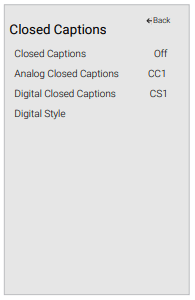
Changing the Appearance of Digital Closed Captions
Digital closed captions can be displayed according to your preference. See the diagram on the next page for an explanation of the parts of the closed caption area.
To change the appearance of digital closed captions:
1. From the CLOSED CAPTIONS menu, use the Arrow buttons to highlight Digital Style and press OK.
2. Use the Left/Right Arrow buttons on the remote to select Custom. The DIGITAL STYLE menu appears as shown.
3. Use the Up/Down Arrow buttons on the remote to highlight the setting you wish to change, then use the Left/Right Arrow buttons to change the setting:
• Caption Style - Choose As Broadcast to keep default settings or Custom to manually change each setting.
• Text Style - Change the font used for the closed captioning text.
• Text Size - Make the text larger or smaller.
• Text Color - Change the color of the text.
• Text Opacity - Change the transparency of the text.
• Text Edges - Change the effects at the edges of the text, such as raising the edges or adding drop shadows.
• Text Edges Color - Change the color of the text edge effects.
• Background Color - Change the color of the background directly behind the text.
• Background Opacity - Change the transparency of the background directly behind the text.
• Window Color - Change the color of the closed captioning box.
• Window Opacity - Change the opacity of the closed captioning box.
4. When you are satisfied with the appearance of the closed captions, press the Exit button on the remote.
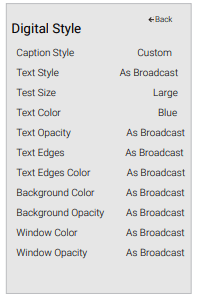
Typical choices include:
• Opaque background, transparent window—Only a strip of background appears behind the text, expanding as the text appears. This is the typical "As Broadcast" mode.
• Opaque background and window in the same color—When text appears, the entire line fills with color at once.
In the example below, the closed caption text is green, the background is black, and the window is red.
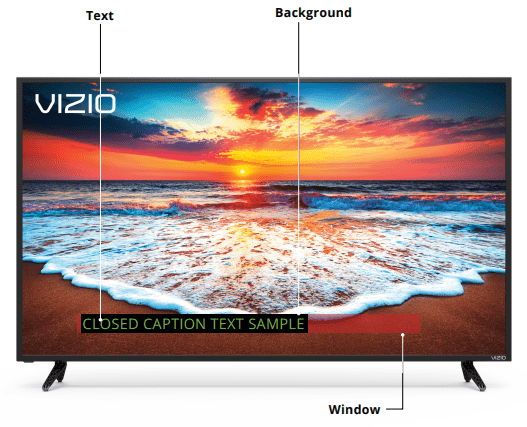
ACCESSIBILITY SETTINGS
VIZIO is committed to providing intuitive, user-friendly products. Your new VIZIO TV offers several accessibility features that can help you get the most out of it.
To access the ACCESSIBILITY menu:
1. Press the Menu button on the remote control.
2. Use the Arrow and OK buttons to navigate and select System à Accessibility.
• Talk Back* - Turn Text-to-Speech Talk Back On or Off. Text-to-Speech Talk Back enables your TV to speak all settings changes and adjustments using the remote in English.
• Speech Rate - Adjusts the rate in which Text-to-Speech is spoken. Select Slow, Normal (Default), or Fast.
• Zoom Mode - Enlarges a section of the screen by approximately 200%.
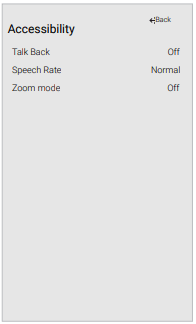
USING THE RESET & ADMIN MENU
You can use the TV’s RESET & ADMIN menu to restore the TV to its factory default settings as well as access other system settings.
Using the RESET & ADMIN, you can:
• Reset the TV to factory settings
• Force the system to power off and on
• Create a system pin code to lock content and picture settings
• Enable or disable program offers and suggestions
• Enable or disable anonymous debug data for system performance.
• Start or stop the Store Demo Mode
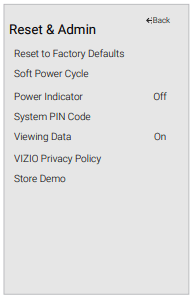
Restoring the TV to Factory Default Settings
All of the on-screen menu settings can be reset to the factory defaults.
To restore the TV to its factory default settings:
1. Press the Menu button on the remote. The on-screen menu is displayed.
2. Use the Arrow buttons on the remote to highlight System and press OK. The SYSTEM menu is displayed.
3. Highlight Reset & Admin and press OK. The RESET & ADMIN menu is displayed.
4. Highlight Reset to Factory Defaults and press OK. If you have changed the set system PIN, enter it now. The TV displays, “Select Reset to restore all TV settings to factory defaults and clear all account information.”
5. Highlight Reset and press OK.
6. Wait for the TV to turn off. The TV will turn back on shortly afterward and the Setup App will begin.
SET SYSTEM PIN
You can set a System PIN to use:
- Picture mode lock
- Parental controls
- Reset to TV to factory default setting
The first time you select System PIN code, you will enter a PIN. The next time you open System PIN code, you can reset your PIN code
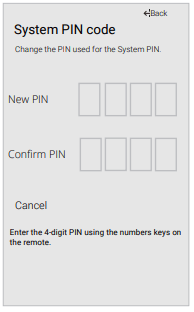
USING THE INFO WINDOW
The INFO window can be displayed by pressing the Info button on the remote:
• Press the Info button one time to display the TV name, current input, picture mode, network name, and time.
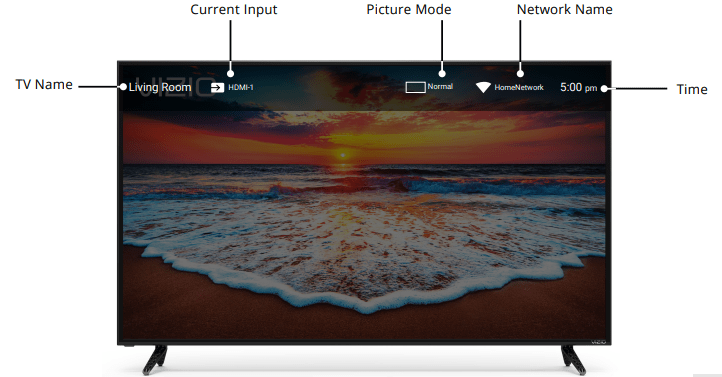
SmartCast TV
What is SmartCast TVSM?
SmartCast TV lets you discover, stream, and control your content like never before. Access top apps like Netflix more easily, using the included remote to browse and launch content directly from the big screen. SmartCast TV makes finding something to watch more fun. Plus, you can quickly set up and adjust settings right on the TV using the included remote control.
What can you do with SmartCast TVSM?
- Browse and launch top tier apps directly from the big screen using the included remote.
- Stream content directly from the home screen with a single button press.
- Stream high quality entertainment in Full HD.
- Initiate a stream with the included IR remote, pause with mobile app, continue controlling with voice via Google Home
How to Launch SmartCast TVSM
To launch and begin streaming with SmartCast TV:
- Press the V Logo button (
 ) on your remote
) on your remote
-OR-
- Select SmartCast from the list of inputs.
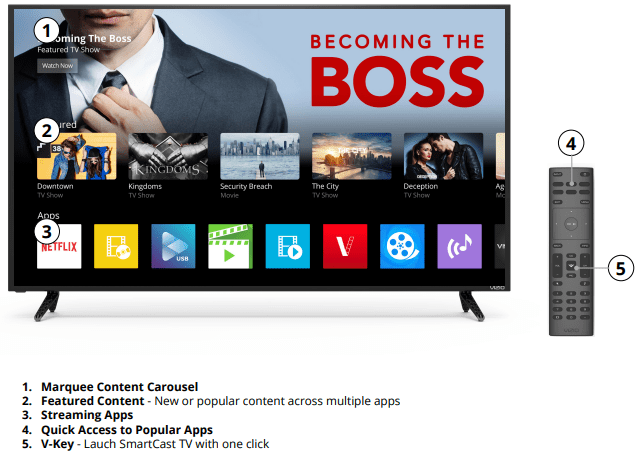
Playing USB Media
Playing USB Media
You to connect a USB thumb drive to your TV to play videos.

Preparing Your USB Drive to Play USB Media
To TV USB media, you must first save your videos onto a USB thumb drive:
- The USB thumb drive must be formatted as FAT32.
- Files on the USB thumb drive must end in a supported file extension ( .mp4 only).
- The player is not designed to play media from external hard drives, MP3 players, cameras, or smartphones.
TVing USB Media
To TV your USB media:
1. Connect your USB thumb drive to the USB port on the side of the TV.
2. The TV will recognize the USB stick and begin playing conent on its own.
-OR
Select USB from the bottom streaming icons on the SmartCast Homepage.
You can TV your photos in fullscreen. Select the photo, press OK, then highlight Fullscreen and press OK.
Removing the USB Drive from the TV
To safely remove your USB drive from the TV:
- Turn off the TV.
- Disconnect your USB thumb drive from the USB port on the side of the TV.
Do not remove the USB thumb drive while the TV is on. Doing so may damage the drive.
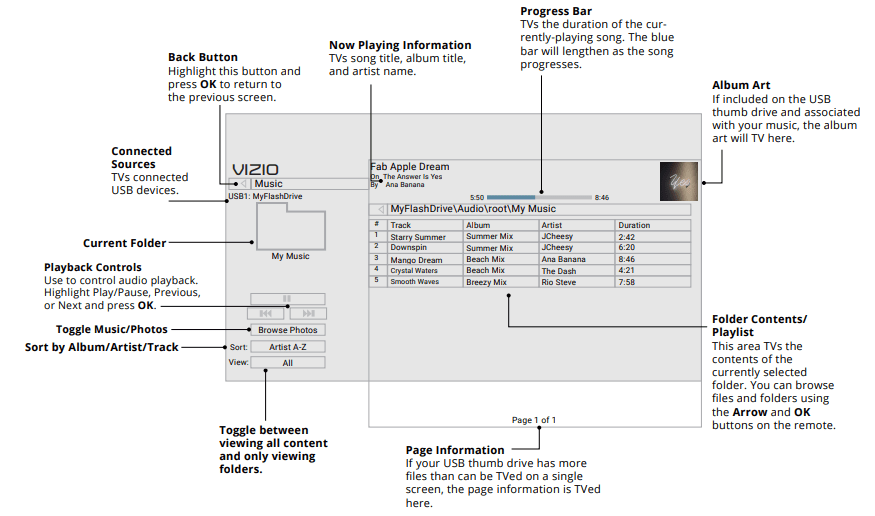
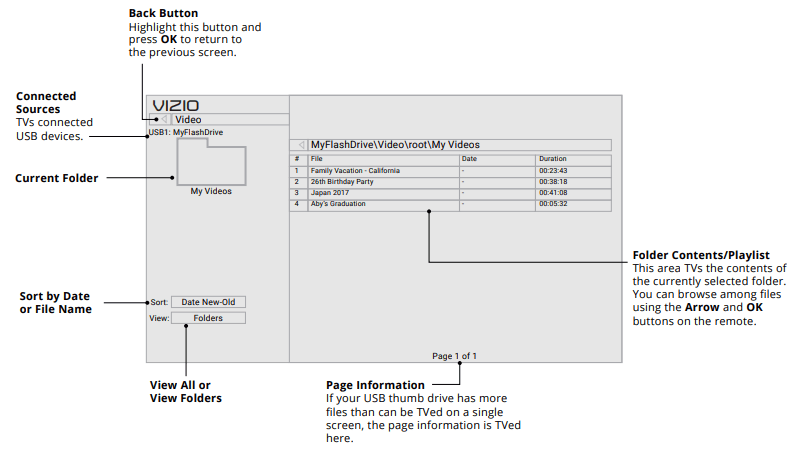
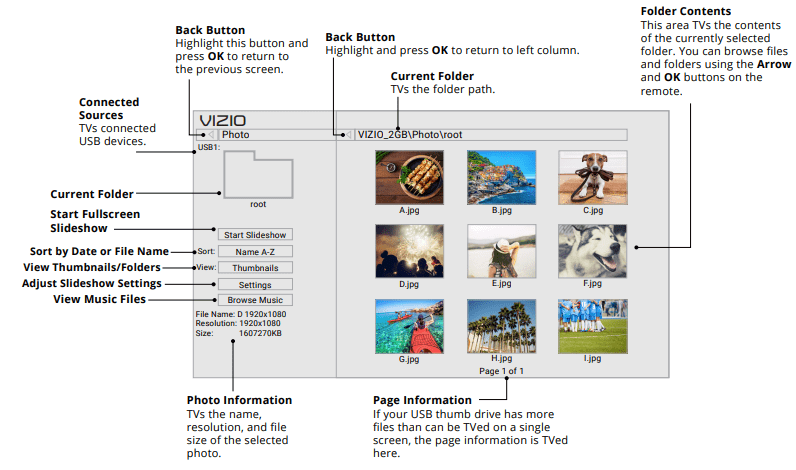
HELP TOPICS
The remote is not responding.
- Make sure the batteries are properly inserted matching the - and + symbols.
- Replace the batteries with fresh ones.
The TV displays “No Signal.”
- Press Input button on the remote control to select a different inpput source.
- If you are using cable TV or antenna connected directly to the TV, scan for channels. See Scanning for Channels.
There is no power.
- Ensure the TV is plugged into a working electrical outlet.
- Ensure the power cable is securely attached to the TV.
- Press the Power/Standby button on the remote or on the back of the TV to turn the TV on.
The power is on, but there is no image on the screen.
- Ensure all cables are securely attached to the TV.
- Ensure all devices are connected correctly. Devices differ; see your device’s user manual for details.
- Adjust Brightness, Contrast, or Backlight. See Adjusting the Picture Settings.
- Press the Input button on the remote to select a different input source.
I see “noise” or static on the screen.
- When your TV’s digital capabilities exceed a digital broadcast signal, the signal is up-converted (improved) to match your TV’s display capabilities. This up-converting can sometimes cause irregularities in the image.
- If you are using an antenna, the signal strength of the channel may be low. Ensure your antenna is connected securely to the TV and move the antenna around the room or close to a window for the best signal.
There is no sound.
- Press Volume Up on the remote control.
- Press the Mute button on the remote to ensure mute is off.
- Check the audio settings. See Adjusting the Audio Settings.
- Check the audio connections of external devices (Blu-ray player, game console, cable/satellite box) that are connected to the TV.
- If you are using an antenna, the signal strength of the channel may be low. Ensure your antenna is connected securely to the TV and move the antenna around the room or close to a window for the best signal.
The sound is flat or dialog is not audible.
- Turn off Volume Leveling. See Adjusting the Audio Settings.
The colors on the TV don’t look right.
- Adjust the Color and Tint settings in the Picture menu. See Adjusting the Picture Settings.
- Select a pre-set picture mode. See Adjusting the Picture Settings. VIZIO recommends selecting Calibrated.
- Check all cables to ensure they are securely attached.
The buttons on the remote aren’t working.
- Ensure you are only pressing one button at a time.
- Point the remote directly at the TV when pressing a button.
- Replace the remote batteries with new ones. See Replacing the Batteries.
The image quality is not good.
- For the best image quality, view high-definition programs using digital sources. Connect your devices with HDMI cables.
- If you are using an antenna, the signal strength of the channel may be low. Ensure your antenna is connected securely to the TV and move the antenna around the room or close to a window for the best signal.
The picture is distorted.
- Move the TV away from electrical appliances, cars, and fluorescent lights.
- Ensure all cables are securely attached.
The display image does not cover the entire screen.
- If you are using TV, AV, or Component with 480i input, press the
 button on the remote to change the screen mode.
button on the remote to change the screen mode.
The TV has pixels (dots) that are always dark.
- Your HD TV is precision-manufactured using an extremely high level of technology. However, sometimes pixels may not display correctly. These types of occurrences are inherent to this type of product and do not constitute a defective product.
When I change input source, the display image changes size.
- The TV remembers the viewing mode on each input source. If the viewing mode on the new input source differs from the one on the input source you switch from, the difference may be noticeable.
- See Changing the Screen Aspect Ratio
How do I watch Cable/Antenna TV channels?
- If you subscribe to cable or satellite, simply connect an HDMI cable (not included) to the receiver.
- If you use external antennas to watch local broadcast channels, connect via coaxial.
How do I change the Inputs?
- Press the Input button on the back of the TV to cycle through the Inputs.
- Press the Input button on the remote to cycle through the Inputs.
- If the VIZIO SmartCast™ App is installed on your phone or tablet, open the VIZIO SmartCast™ App. Tap on the Device list and select your TV. Tap on the Input key and select the Input of your choice
How do I connect to my Wi-Fi network?
- On your remote, press the Menu button then go to Network → Select your Wi-Fi name → Enter password.
- If the VIZIO SmartCast™ App is installed on your phone or tablet, open the VIZIO SmartCast™ App. Tap on the device list and select your TV. Tap on the Settings icon → Network → Wireless Access Points. Select your Wi-Fi network from the list, enter the Wi-Fi password, and tap Connect.
How do I stream apps like Netflix and Youtube to my VIZIO SmartCast™ TV?
- Launch SmartCast TVSM. Press the V Logo button (
 ) on your remote or select SmartCast from the list of inputs.
) on your remote or select SmartCast from the list of inputs. - Download and open a Chromecast-enabled apps on your mobile device, such as like Netflix or Youtube. Then tap the Cast button.
How do I exit Demo Mode?
- Press and hold the Input button on the back of the TV to exit the demo mode
How do I download the VIZIO SmartCast™ App?
- Make sure your phone or tablet is connected to a Wi-Fi network. Open a browser on your phone or tablet. Navigate to vizio.com/smartcastapp and follow the on-screen instructions to download the VIZIO SmartCast™ App.
See other models: E320VL E32-C1 D39f-F1 D48-D0 D40u-D1
